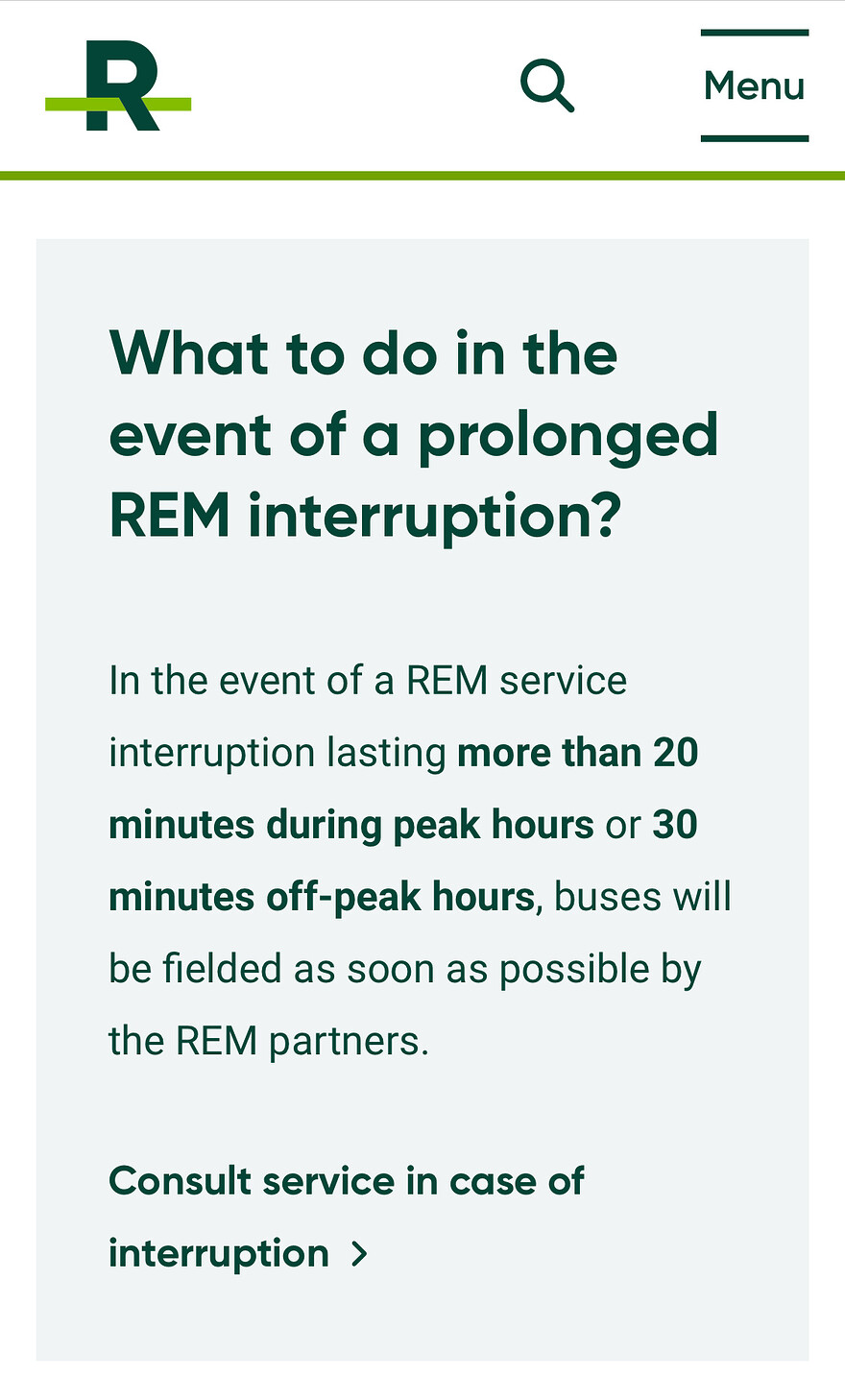Service starting to resume again
ummm we’re still staying on bus even though by the time we got to Panama I clearly saw 2 REM take off while they asked our driver to pick up some other folks…okk
Ça ressemble à quoi l’achalandage en dehors des heures de pointe en journée? J’ai des amis qui veulent faire un tour avec des jeunes enfants et ne veulent pas être trop dans les foules. ![]()
It’s “semantics” in the sense that mode definition has very little importance for commuters. However, if we are talking about the REM to the extent we have been here, it’s important to acknowledge the importance of the terms we use and not be dismissive of language. If we’re interested enough in the subject to post here, we should not take the terminology as trivial.
“Subway” and “Light rail” are misnomers that simultaneously illustrate the American hegemony on language, and yet how out of phase American (and Canadian) English is with the critical features of those modes. Most subways are not “sub”, but “over the ways” either on the surface or elevated on significant part of their length. Many LRT lines are most absolutely not “light” in capacity and infrastructure.
Subway and light rail, the former more specifically, are marketing tools rather than a reality.
Subway falsely suggest to residents, and other stakeholders along a line, that the trains will be out of sight out of mind, unlike “bad”conventional mainline trains. LRT also play’s on negative rail expectations in its own way. Over time as the word “tram” started to be used pejoratively, those pushing for tramways to be built switched to calling them LRT.
Personally, like most of the planet, I’ll always favour the terms “metro” and “tram”.
And while the overuse of the term LRT led to some metros being referred to as light rail and the vagueness of the original Champlain bridge rail link project added to the confusion, the REM fits the definition of metro of every major public transportation professionals and organizations.
Je vois bcp de bancs vides dans les rames qui passent entre les deux périodes de pointe
Par contre, les gens semblent s’entasser à l’avant ou à l’arrière pour profiter des grandes baies vitrées
L’achalandage était plutôt léger lundi soir dès 18h15. J’imagine que c’est juste en pointe qu’il peut y avoir des foules dorénavant.
La chroniqueuse circulation de Radio-Canada parle de problème informatique comme cause de la panne de ce matin
Concernant les critiques sur les pannes de lundi, un petit rappel du premier jour de mise en service du métro
Merci pour ta revue du REM!
@Michael_A a déjà argumenté très bien sur le sujet, mais je serais curieux de savoir pourquoi, toi, tu penses que le REM est un LRT au lieu d’un métro léger.
Pour moi le terme « SLR » (français) fonctionne bien pour désigner un système hybride comme Calgary. Ils utilisent des rames à plancher haut mais partiellement sur rue.
Sinon dans bien cas les lignes de SLR en Amérique du Nord sont simplement des lignes de tramways modernes.
Suis présentement dans le REM. On a atteint une vitesse maximale de 82 km/h, mais on dépasse rarement 70 km/h au milieu de l’A10
Edit : ah non on est à 90 km/h entre Panama et du Quartier maintenant. Mais je m’attendais à plus que 70 km/h en descendant le pont Champlain vers Panama
Edit 2 : il y a des tests bizarres de comms… On vient de nous souhaiter la bienvenue à Deux-Montagnes, correspondance avec la ligne verte… wtf
I think we’ve been over this a few times, but one very loose definition for “light rail” is based upon overall capacity for a line or a system. Four-car REM-A trains have a maximum capacity of 780 riders, and with theoretical minimum headways of 90 seconds, REM is technically able to carry over 31,000 passengers per hour per direction, well into “heavy metro” territory.
REM can quite correctly be labelled a “medium capacity transit system,” or even an “intermediate capacity transit system” – ICTS, the original branding for UTDC’s (later Bombardier’s) Scarborough RT and Vancouver SkyTrain.
Est-ce qu’il y a un indicateur de vitesse sur les panneau d’affichage ou est-ce que vous utiliser un autre moyen pour obtenir la vitesse? Si il n’y en a pas, ça serait vraiment bien d’en ajouter un.

I use a GPS app when I’m on trains. Hit 430 on the Shanghai maglev!
A glossary of term pinned somewhere on the forums might be a good idea since those conversations do indeed seem to come back often. If its not LRT, its something else. Every few weeks, there’s somebody new joining the forum who doesn’t have that knowledge.
Je suis allé hier entre midi et 14h et c’était plutôt tranquille.
Or maybe links to Wikipedia pages, I agree. Of all the terms, LRT and Light Rail are the most nebulous. They don’t really have a single definition.
I do think that I gave a rather good definition when answering @EdwinG
I’d offer a slightly specific definition for “light rail” or “LRT”: any lower-capacity (<20,000 passengers per hour per direction) rail transit line using shorter trains that has incursions with surrounding activity (mixed-traffic, segregated street-running, intersections, or level crossings) at any point along the line.
